Key Takeaways:
- Research the specific needs and behaviors of hamsters to ensure you are providing a suitable environment for the new pet.
- Introduce slowly and in a controlled environment to prevent stress and potential conflicts with existing pets.
- Monitor closely for any signs of illness or distress, and seek veterinary care as soon as needed.

Preparing Your Home
Obviously, before bringing a new hamster into your household, you need to prepare your home to ensure a safe and comfortable environment for your new pet. This involves gathering the necessary supplies and creating a suitable living space for your hamster.
Essential Hamster Supplies
When preparing to bring a new hamster into your home, it’s important to gather all the essential supplies beforehand. These include a suitable cage with proper ventilation and space for your hamster to move around. You will also need bedding, food and water dishes, and a wheel for exercise. Additionally, chew toys and hiding spots are crucial for your hamster’s mental and physical well-being. Don’t forget to have a supply of hamster food, as well as treats, on hand before bringing your new pet home.
Creating a Safe and Comfortable Environment
Creating a safe and comfortable environment for your new hamster involves setting up their living space in an area of your home that is free from drafts, direct sunlight, and extreme temperature fluctuations. Place the cage on a stable surface, away from the reach of other pets or small children. Be sure to provide ample bedding material for burrowing and consider adding climbing structures or tubes for added enrichment. Finally, ensure that the cage is escape-proof to prevent your hamster from getting loose in your home.
Understanding Hamster Behavior
Clearly, understanding hamster behavior is crucial when introducing a new hamster to your household. Hamsters are small, prey animals with specific behavioral traits that differ from those of other pets, such as dogs or cats. By understanding their behavior, you can create a more comfortable and safe environment for your new pet.
Common Hamster Traits and Habits
One important trait to be aware of is that hamsters are nocturnal animals, meaning they are most active at night and sleep during the day. Additionally, hamsters are solitary creatures and may become stressed when housed with other hamsters. They are also known for their burrowing behavior, so providing them with plenty of bedding material and items to burrow in is essential for their well-being.
Communication and Stress Signals in Hamsters
Communication in hamsters is mainly non-verbal, and they use a variety of body language and vocalizations to express their emotions. For example, when a hamster feels threatened or stressed, they may exhibit behaviors such as freezing in place, excessive grooming, or even biting. It’s important to pay attention to these signals and create a calm and safe environment for your hamster.
When considering bringing a new hamster into your household, there are several crucial factors to keep in mind to ensure a smooth and successful transition for both you and your new pet. Introducing a new hamster into your home can be an exciting and rewarding experience, but it is important to consider their needs and the potential challenges that may arise. From proper habitat and diet to socialization and potential health risks, there are several important considerations to keep in mind when welcoming a new hamster to your family.
Health and Wellness
To ensure the well-being of your new hamster during the introduction process, there are several health and wellness considerations to keep in mind. Proper monitoring of your hamster’s health, as well as meeting their nutritional needs, are essential for a successful transition into your household.
Monitoring Your Hamster’s Health During Introduction
During the initial stages of introducing your new hamster to your household, it’s crucial to monitor their health closely. Look out for any signs of illness or distress, such as changes in appetite, lethargy, or abnormal behavior. A trip to the veterinarian might be necessary if you notice any concerning symptoms. Additionally, make sure to provide a clean and comfortable living environment for your hamster to minimize the risk of health issues.
Nutritional Needs and Feeding Recommendations
Proper nutrition is key to supporting your new hamster’s health and well-being. Ensure that you provide a balanced diet that includes a mix of hamster pellets, fresh vegetables, and the occasional treat. Avoid feeding your hamster sugary or fatty foods, as these can lead to obesity and other health problems. Always have fresh water available, and monitor your hamster’s eating habits to ensure they are getting the nutrients they need.
Long-Term Integration
Lastly, when introducing a new hamster to your household, it’s important to consider the long-term integration of your pet into your family. This includes creating a comfortable and safe living environment for your hamster, as well as establishing a routine for feeding, cleaning, and interacting with your pet. Remember that hamsters are small, delicate creatures, and they can easily become stressed or overwhelmed if there are sudden changes in their environment. Take the time to slowly integrate your new pet into your home and be patient as they adjust to their new surroundings.
Maintaining a Happy and Healthy Hamster Life
Once your new hamster has settled into your household, it’s important to focus on maintaining a happy and healthy life for your pet. This includes providing a balanced diet, regular exercise, and appropriate mental stimulation for your hamster. Ensuring that your hamster has a clean and comfortable living environment is also crucial for their well-being. Regularly clean their cage and provide fresh bedding, food, and water to keep them happy and healthy.
Troubleshooting Common Issues Post-Introduction
After introducing a new hamster to your household, you may encounter some common issues such as territorial behavior, aggression towards other pets, or signs of illness. It’s important to be vigilant and address any issues as soon as they arise. Keep an eye on your hamster’s behavior and seek advice from a veterinarian if you have any concerns about your pet’s health or well-being.
Recap of Key Considerations
As a responsible hamster owner, it’s important to recap the key considerations when introducing a new hamster to your household. This includes providing a suitable living environment, establishing a routine for care and interaction, and being attentive to any changes in your hamster’s behavior or health. By staying informed and proactive, you can ensure the well-being of your pet and create a harmonious living environment for everyone in your household.
Ensuring a Smooth Transition for Your New Pet
When introducing a new hamster to your household, it’s essential to ensure a smooth transition for your new pet. This includes providing a quiet and secure space for your hamster to get accustomed to their new surroundings, as well as gradually introducing them to other pets in the household. By taking the time to acclimate your hamster to their new environment and being patient with their adjustment process, you can help ensure a positive and stress-free transition for your new pet.
FAQ
Q: What are some important considerations to keep in mind when introducing a new hamster to your household?
A: When introducing a new hamster to your household, it’s crucial to consider the size and layout of the enclosure. Ensure that the cage is large enough to accommodate multiple hamsters and has enough hiding spots and toys for each hamster. Additionally, carefully monitor the interactions between the new and existing hamsters to ensure they are getting along and not displaying any aggressive behavior.
Q: How should I introduce a new hamster to my household and existing hamster(s)?
A: Proper introduction of a new hamster to existing household hamsters is essential to reduce the risk of aggression and territorial disputes. Start by placing the new hamster’s cage in the same room as the existing hamsters for a few days to allow them to become accustomed to each other’s scent. Once they seem comfortable, introduce them in a neutral space, such as a bathtub, while closely supervising their interactions. Be prepared to separate them if any aggression occurs.
Q: What should I do if the new hamster seems to be struggling to adjust to the existing household environment?
A: It’s not uncommon for a new hamster to struggle with adjusting to a new household environment. If the new hamster seems stressed, provide plenty of hiding spots, toys, and bedding material in their cage to help them feel secure. Additionally, limit interaction with the hamster for the first few days to allow them to acclimate to their new surroundings. If the behavioral issues persist, consult with a veterinarian or a professional animal behaviorist for further guidance.














